In civil engineering, geotechnical materials stand for sustainable constructions. In addition to classic geosynthetics, NAUE, manufacturer of geotechnical construction materials, presented its first biodegradable nonwoven, Secutex® Green, last year. This biodegradable nonwoven has already proven itself successfully in various applications. For example, in the dunes of Sylt and under a construction road near Stuttgart, the new nonwoven was an excellent solution.
Sustainable construction in civil engineering is synonymous with “durable”, “long-lasting”, “environmentally friendly”, or “reasonable”. Geotechnical construction materials made of highly developed polymer materials meet these criteria and ensure optimized construction in geotechnical engineering. Due to fewer mass movements, natural resources are conserved, transports are omitted, and the infrastructure is relieved. Thus, geotechnical construction materials reduce CO2 emissions, improve resource efficiency and cut costs. The polymer materials are mainly designed for a very long lifespan.
For applications in which an extremely long lifespan for the separating and filter nonwoven is not necessary, Secutex® Green is an environmentally neutral alternative. The production takes place exclusively from organic, natural, renewable raw materials. The biodegradability is certified by TÜV Austria.
One example is a construction road near Stuttgart in Germany. A water-retaining wall had to be rehabilitated and required a construction road in an ecologically sensitive area. The rehabilitation work was carried out from an “island” between a river and a canal, and only a private footpath was leading to the construction site. In coordination with the authorities, this path had to be expanded into a temporary 3 – 4 m wide construction road that can be used for heavy equipment such as trucks and excavators. As an alternative to the classic construction method with several decimeters thick mineral soil layers, the biodegradable separation nonwoven Secutex® Green was installed on the existing ground. The nonwoven avoided mixing of the ballast with the fine-grained subsoil, which is why considerably less material was needed. This also saved transports and construction time and thus costs. Secutex® Green was the perfect choice of material here, as the nonwoven can be composted after its use for the construction road.
Secutex® Green also proves to be an excellent problem solver in fashionable Kampen on the island Sylt. A beach path with the biodegradable nonwoven was installed between the dunes to improve the way through the dunes to the beautiful North Sea. This path is a significant relief, especially for people with prams, rollators or wheelchairs. Firmly connected to a larch wood, the nonwoven becomes a rollable path that can be easily laid through the dunes. Biologically harmless, the new beach path makes it easier to cross the loose dune sand. Easy and sustainable with clear benefits for the general public, an ideal combination.

